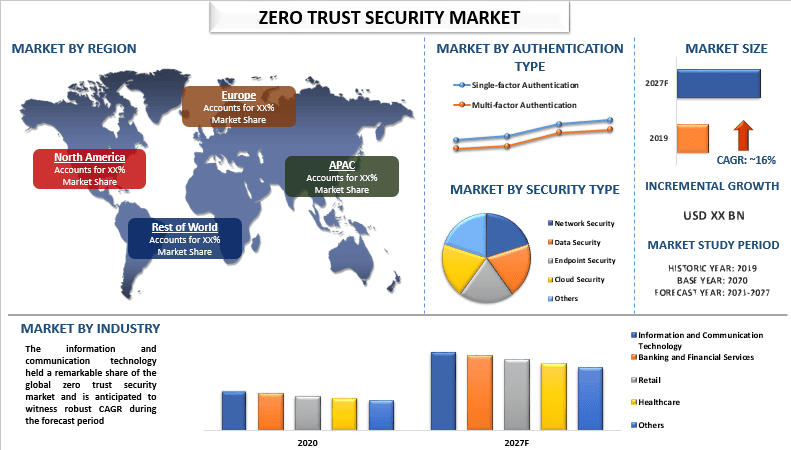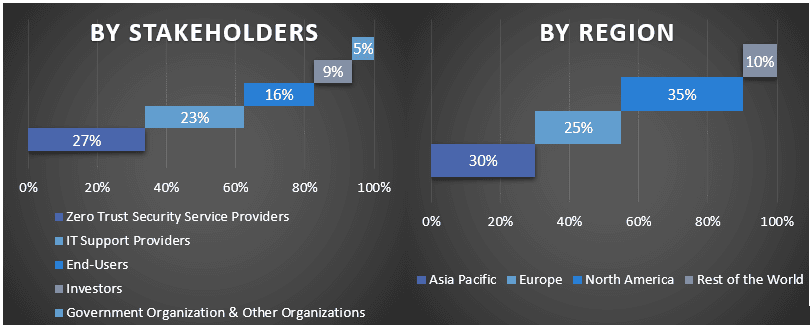Рынок безопасности Zero Trust: Текущий анализ и прогноз (2021-2027)
Акцент на типе безопасности (Безопасность сети, Безопасность данных, Безопасность конечных точек, Безопасность облака и другие); Тип аутентификации (Однофакторная аутентификация и Многофакторная аутентификация); Развертывание (Локальное и Облачное); Размер организации (Крупные предприятия и МСП); Отрасль (Информационные и коммуникационные технологии, Банковские услуги и финансовые услуги, Розничная торговля, Здравоохранение и другие); и Регион/Страна

ЗАПРОСИТЬ БЕСПЛАТНЫЙ ОБРАЗЕЦ PDF
Ожидается, что совокупный среднегодовой темп роста (CAGR) глобального рынка безопасности Zero Trust составит около 16% в период с 2021 по 2027 год. Глобальный рынок безопасности Zero Trust растет за счет непрерывного увеличения количества целевых кибер-атак, необходимости снижения бизнес-рисков и организационных рисков, а также цифровизации ключевых отраслевых направлений. Кроме того, развитие цифровой инфраструктуры в развивающихся странах также окажет положительное влияние на рынок. «Zero Trust» — это фреймворк безопасности, требующий аутентификации, утверждения и постоянной проверки конфигураций и статуса безопасности до того, как всем пользователям, находящимся внутри или за пределами корпоративной сети, будет предоставлен или сохранен доступ к приложениям и данным. Кроме того, растущие потери в результате кибер-атак являются одним из наиболее важных факторов, стимулирующих внедрение безопасности Zero Trust. Например,по данным Internet Crime Complaint Center (IC3), в 2018 году общие финансовые потери от киберпреступности составили около 2,7 млрд долларов США в год, что увеличилось до более чем 4 млрд долларов США в год в 2020 году.
Palo Alto Networks Inc., Cisco Systems Inc., International Business Machines Corporation, Fortinet Inc., Citrix Systems Inc., Sophos Group plc, Check Point Software Technologies Ltd., VMware Inc., Microsoft Corporation и Akamai Technologies Inc. являются одними из ключевых игроков на рынке. Эти игроки провели несколько слияний и поглощений, а также партнерств, чтобы предоставить клиентам высокотехнологичные и инновационные продукты/технологии.
Представленные в отчете данные
«Среди типов безопасности сегмент безопасности конечных точек занимал значительную долю рынка в 2020 году»
Основываясь на типе безопасности, рынок делится на безопасность сети, безопасность данных, безопасность конечных точек, безопасность облака и другие. Среди них сегмент безопасности конечных точек занимал значительную долю глобального рынка безопасности Zero Trust в 2020 году и, как ожидается, продемонстрирует значительный рост в течение прогнозируемого периода из-за цифровой трансформации бизнеса, которая увеличила использование устройств конечных точек, таких как мобильные телефоны, ноутбуки, персональные компьютеры и другие. Конечная точка действует как точка входа в корпоративную сеть, создавая точку входа, которая может быть использована злоумышленником. Следовательно, важно защищать эти конечные точки, чтобы защитить бизнес от рискованных действий и вредоносных атак.
«Среди типов аутентификации многофакторная аутентификация обеспечила значительную долю рынка в 2020 году»
Основываясь на типе аутентификации, рынок разделен на однофакторную аутентификацию и многофакторную аутентификацию. Среди них тип многофакторной аутентификации обеспечил значительную долю глобального рынка безопасности Zero Trust в 2020 году и, как ожидается, также продемонстрирует значительный рост в течение прогнозируемого периода. Это связано с тем, что многофакторная аутентификация широко используется во всех отраслях из-за высокого уровня безопасности, обеспечиваемого многофакторной аутентификацией. Многофакторная аутентификация является ключевым компонентом безопасности Zero Trust для повышения безопасности. Хотя для хакеров может быть полезно определить один фактор авторизации, несколько уровней проверки и мониторинга доступа в режиме реального времени важны для соблюдения модели безопасности Zero Trust.
«Северная Америка продемонстрирует значительный рост в течение прогнозируемого периода»
Северная Америка занимала значительную долю рынка в 2020 году и, как ожидается, продемонстрирует значительные темпы роста в течение прогнозируемого периода. Рост этого рынка можно объяснить присутствием ключевых игроков рынка в регионе и быстрым внедрением новых технологий. Растущая розничная торговля, банковские услуги и финансовые услуги, информационные и коммуникационные технологии и другие отрасли также способствуют росту рынка безопасности Zero Trust в регионе. Кроме того, рост числа кибер-атак также способствует росту этого рынка в регионе. Например,в 2020 году в Соединенных Штатах было зарегистрировано почти 790 000+ жалоб на киберпреступления, что привело к убыткам в размере 4,2 млрд долларов США, но в 2021 году количество жалоб увеличилось почти до 850 000, что привело к убыткам в размере 6,9 млрд долларов США.
Причины купить этот отчет:
- Исследование включает анализ размеров рынка и прогнозирования, подтвержденный аутентифицированными ключевыми отраслевыми экспертами.
- Отчет представляет собой краткий обзор общей эффективности отрасли с первого взгляда.
- Отчет содержит углубленный анализ выдающихся отраслевых компаний с основным акцентом на ключевых финансовых показателях бизнеса, портфеле продуктов, стратегиях расширения и недавних разработках.
- Подробное изучение факторов, сдерживающих факторов, ключевых тенденций и возможностей, преобладающих в отрасли.
- Исследование всесторонне охватывает рынок по различным сегментам.
- Углубленный анализ отрасли на региональном уровне.
Варианты настройки:
Глобальный рынок безопасности Zero Trust может быть дополнительно настроен в соответствии с требованиями или любым другим сегментом рынка. Кроме того, UMI понимает, что у вас могут быть свои собственные бизнес-потребности, поэтому, пожалуйста, свяжитесь с нами, чтобы получить отчет, который полностью соответствует вашим требованиям.
Содержание
Методология исследования для анализа рынка безопасности Zero Trust (2021-2027)
Анализ исторического рынка, оценка текущего рынка и прогнозирование будущего рынка глобального рынка безопасности Zero Trust были тремя основными этапами, предпринятыми для создания и анализа внедрения безопасности Zero Trust в основных регионах мира. Для сбора исторических рыночных данных и оценки текущего размера рынка были проведены исчерпывающие вторичные исследования. Во-вторых, чтобы подтвердить эти выводы, были приняты во внимание многочисленные результаты и предположения. Кроме того, были проведены исчерпывающие первичные интервью с отраслевыми экспертами по всей цепочке создания стоимости глобального рынка безопасности Zero Trust. После предположения и проверки рыночных данных с помощью первичных интервью мы использовали восходящий/нисходящий подход для прогнозирования общего размера рынка. После этого были приняты методы разбивки рынка и триангуляции данных для оценки и анализа размера рынка сегментов и подсегментов отрасли. Подробная методология объясняется ниже:
Анализ исторического размера рынка
Шаг 1: Углубленное изучение вторичных источников:
Детальное вторичное исследование было проведено для получения исторического размера рынка безопасности Zero Trust из внутренних источников компании, таких какгодовые отчеты и финансовые отчеты, презентации о производительности, пресс-релизы и т. д.,и внешние источники, включаяжурналы, новости и статьи, правительственные публикации, публикации конкурентов, отраслевые отчеты, сторонние базы данных и другие авторитетные публикации.
Шаг 2: Сегментация рынка:
После получения исторического размера рынка безопасности Zero Trust мы провели подробный вторичный анализ для сбора исторических данных о рынке и доли для различных сегментов и подсегментов для основных регионов. Основные сегменты, включенные в отчет, включают тип безопасности, тип аутентификации, развертывание, размер организации и отрасль. Дальнейший анализ на уровне стран был проведен для оценки общего внедрения моделей тестирования в этом регионе.
Шаг 3: Факторный анализ:
После получения исторического размера рынка различных сегментов и подсегментов мы провели подробныйфакторный анализдля оценки текущего размера рынка безопасности Zero Trust. Кроме того, мы провели факторный анализ с использованием зависимых и независимых переменных, таких как различные типы безопасности, типы аутентификации, развертывание, размер организации и отрасль безопасности Zero Trust. Был проведен тщательный анализ сценариев спроса и предложения с учетом основных партнерств, слияний и поглощений, расширения бизнеса и запусков продуктов в секторе рынка безопасности Zero Trust по всему миру.
Оценка и прогноз текущего размера рынка
Оценка текущего размера рынка:Основываясь на практических выводах из вышеуказанных 3 шагов, мы пришли к текущему размеру рынка, ключевым игрокам на глобальном рынке безопасности Zero Trust и долям рынка сегментов. Все необходимые доли в процентах и разбивки рынка были определены с использованием вышеупомянутого вторичного подхода и были проверены с помощью первичных интервью.
Оценка и прогнозирование:Для оценки и прогнозирования рынка веса были присвоены различным факторам, включая движущие силы и тенденции, ограничения и возможности, доступные для заинтересованных сторон. После анализа этих факторов были применены соответствующие методы прогнозирования, т.е. восходящий/нисходящий подход, для получения рыночного прогноза примерно до 2027 года для различных сегментов и подсегментов на основных рынках мира. Методология исследования, принятая для оценки размера рынка, включает:
- Размер рынка отрасли с точки зрения выручки (в долларах США) и скорость внедрения рынка безопасности Zero Trust на основных рынках внутри страны
- Все процентные доли, разделения и разбивки рыночных сегментов и подсегментов
- Ключевые игроки на мировом рынке безопасности с нулевым доверием с точки зрения предлагаемых решений. Кроме того, стратегии роста, принятые этими игроками для конкуренции на быстрорастущем рынке
Проверка размера и доли рынка
Первичные исследования:Углубленные интервью были проведены с ключевыми лидерами мнений (KOL), включая руководителей высшего звена (CXO/VP, руководители по продажам, руководители по маркетингу, руководители по операционной деятельности, региональные руководители, руководители стран и т. д.) в основных регионах. Результаты первичных исследований были затем обобщены, и был проведен статистический анализ для подтверждения заявленной гипотезы. Данные первичных исследований были консолидированы с вторичными результатами, что превратило информацию в практические выводы.
Разбивка основных участников по различным регионам

Инженерия рынка
Метод триангуляции данных был использован для завершения общей оценки рынка и получения точных статистических данных для каждого сегмента и подсегмента мирового рынка безопасности с нулевым доверием. Данные были разделены на несколько сегментов и подсегментов после изучения различных параметров и тенденций в областях типа безопасности, типа аутентификации, развертывания, размера организации и отрасли на мировом рынке безопасности с нулевым доверием.
Основная цель исследования мирового рынка безопасности с нулевым доверием
В исследовании были определены текущие и будущие тенденции рынка безопасности с нулевым доверием. Инвесторы могут получить стратегическую информацию для обоснования своих решений об инвестициях на основе качественного и количественного анализа, проведенного в исследовании. Текущие и будущие тенденции рынка определили общую привлекательность рынка на региональном уровне, предоставив участникам отрасли платформу для использования неиспользованного рынка для получения выгоды в качестве первого шага. Другие количественные цели исследований включают:
- Проанализировать текущий и прогнозируемый размер рынка безопасности с нулевым доверием в стоимостном выражении (USD). Кроме того, проанализировать текущий и прогнозируемый размер рынка различных сегментов и подсегментов
- Сегменты исследования включают области типа безопасности, типа аутентификации, развертывания, размера организации и отрасли.
- Определение и анализ нормативно-правовой базы для отрасли безопасности с нулевым доверием.
- Анализ цепочки создания стоимости с учетом присутствия различных посредников, а также анализ поведения клиентов и конкурентов в отрасли.
- Проанализировать текущий и прогнозируемый размер рынка безопасности с нулевым доверием для основного региона.
- Основные страны регионов, изученных в отчете, включают Азиатско-Тихоокеанский регион, Европу, Северную Америку и остальной мир.
- Профили компаний рынка безопасности с нулевым доверием и стратегии роста, принятые игроками рынка для поддержания устойчивости на быстрорастущем рынке
- Углубленный анализ отрасли на региональном уровне
Связанные Отчеты
Клиенты, купившие этот товар, также купили










